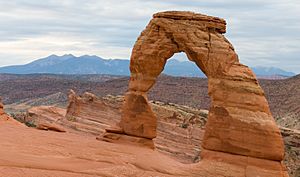Natural arch facts for kids
A natural arch is a cool rock formation that looks like a bridge or an archway. It's made by nature, usually from rock, with an open space underneath. People sometimes call them natural bridges or rock arches. These amazing structures often form near the sea, rivers, or in places where the weather slowly wears away the rock.
Contents
Natural Arches: Nature's Stone Bridges
Natural arches are mostly made from strong rocks like sandstone or limestone. These rocks are often found in long, narrow ridges called fins or tall, isolated rock columns called stacks.
How Do Natural Arches Form?
Natural arches are created by a process called erosion. Erosion happens when natural forces like water, wind, or ice slowly wear away rock.
- Water Erosion: When waves crash against coastal cliffs or rivers flow through canyons, they can carve out softer parts of the rock. Over thousands of years, this constant wearing away can create an opening, forming an arch. For example, a river might flow in a big curve, called a meander. If the river cuts through a narrow neck of rock in its curve, it can create a natural bridge.
- Weathering: Weathering is another way rocks break down. This can happen when water freezes and expands in cracks, or when chemicals in the air and water slowly dissolve the rock. This process weakens the rock, making it easier for wind and water to carry away loose pieces.
- Combined Forces: Often, a mix of water erosion and weathering works together to shape these arches. The harder parts of the rock remain, while the softer parts are removed, leaving a beautiful archway.
Where Can We Find Natural Arches?
You can find natural arches all over the world! They are common in places with lots of sandstone or limestone and strong natural forces. Many famous arches are found in national parks, especially in the western United States.
Some arches are very large, like Landscape Arch in Utah, which is one of the longest in the world. Others are smaller or are still forming. Sadly, some famous arches, like the Azure Window in Malta, have collapsed over time due to continued erosion. This shows that natural arches are always changing, even if it happens very slowly.
Images for kids
-
The Azure Window, Malta, which collapsed in 2017
-
Metate Arch, Devils Garden (GSENM), a very thin arch near the end of its life
-
A topographic map of Coyote Natural Bridge in Utah shows how the meandering Coyote Gulch carved a shorter route through the rock under the arch. The old riverbed is now higher than the present water level.
-
Arch in Timna Valley Park, Negev Desert, Israel
-
Es Pontàs is a natural arch on the coast of Mallorca, Spain
-
Durdle Door, Dorset, the United Kingdom
-
Percé Rock, Quebec, Canada
-
The Arch of Cabo San Lucas, Mexico
-
Holei Sea Arch, Hawaii Volcanoes National Park, Hawaii, United States
-
Landscape Arch, Utah, United States - one of the longest natural arches in the world
-
Rainbow Bridge, Utah, a natural bridge formed by a meandering watercourse
-
"The Hole in the Rock” on Piercy Island, Cape Brett, New Zealand
-
The arch at Tunnel Beach, Dunedin, New Zealand
See also
 In Spanish: Arco natural para niños
In Spanish: Arco natural para niños


















